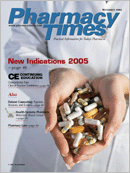Publication
Article
Pharmacy Times
CASE STUDIES
Author(s):
CASE ONE:WS, a 56-year-old man, presentsto USA Pharmacy and asksto speak with the pharmacist. Heexplains that he quit smoking 3days earlier. He had smoked 2packs a day for 30 years. WShas never before attempted toquit smoking. When his 5-yearoldgranddaughter told him thatsmoking was "gross," he decided that it was time to quit.
WS tells the pharmacist that he has been using a nicotinepatch. He applies the patch in the morning and leaves it inplace for 24 hours before replacing it. He has experiencedonly minimal cravings.
WS is concerned about his sudden inability to sleep. Whenhe does manage to fall asleep, he is plagued by nightmares.He wonders whether this condition is due to the fact that hequit smoking.
What might be a possible cause (and cure) for WS'sinsomnia and nightmares?
CASE TWO:GA, a 76-year-old woman,visits the ambulatory care clinicfor evaluation of recent episodesof confusion, rapid heartrate, and sweating. During thepast week, GA has experienced6 episodes of suddenconfusion, nausea, tremulousness,and sweatiness. She alsofeels as though her heart is racing. GA cannot identify whatcauses these symptoms. When the symptoms start, she sitsdown to rest and drinks some juice until she feels better.
GA's medical history is significant for hypertension, diabetesmellitus, and hyperlipidemia. She does not smoke ordrink alcohol. Her current medications include atorvastatin,40 mg daily; quinapril, 20 mg daily; chlorpropamide, 250 mgdaily; and aspirin, 81 mg daily.
The physician suspects that GA is suffering from episodesof hypoglycemia. He decides that a change in GA's medicationsis necessary. He knows that GA is on a tight budget, sohe asks the pharmacist what medications are available freeof charge through the clinic. The pharmacist informs him thatmultiple strengths of chlorpropamide, multiple strengths ofglipizide, and various insulins are available.
After explaining GA's situation, the physician asks thepharmacist what she recommends to control GA's bloodsugars.
What should the pharmacist recommend?
Click Here For The Answer ----------->
[-]
CASE ONE: Because WS is wearing a 24-hour patch, nicotine levels are maintained around the clock. Nocturnal nicotine levelsare associated with insomnia and nightmares. To reduce the incidence of these side effects, WS can remove the patch at bedtime. He also canconsider using a 16-hour patch, rather than one that is formulated for 24-hour use. If applied in the morning, the 16-hour patch will provide lowerconcentrations at night.
CASE TWO: Chlorpropamide's long half-life and active metabolites may be contributing to GA's hypoglycemia. Rather than reducing the dose, GAshould be switched to glipizide, a second-generation sulfonylurea that does not have active metabolites. She should be started on a low dose, andthen the dose should be titrated up if needed. GA would not be a candidate for insulin at this time because she already has low blood sugar. If shewere having difficulty keeping her blood sugar down, then insulin would be an option.
toggle(getObject('exp1048685570_link'), 'exp1048685570');







